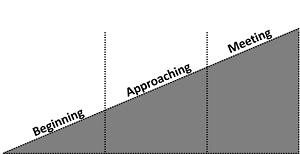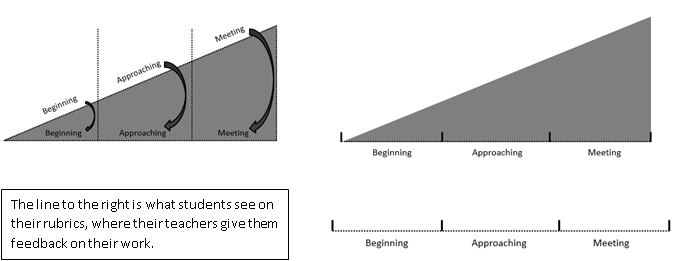With each opportunity to practice, the goal is for students to “climb” a little higher up the mountain.assessment mountain We use the language of “Beginning” (abbreviated as Be), “Approaches” (Ap), and “Meets” (Me) to communicate how close a student is to the “summit” of the mountain. Our belief is that all students can and will get to the top of this mountain (that is, they will MEET standards) through continued effort, practice, and utilization of teacher feedback. It takes most students about two years to consistently meet standards in any domain. When they are consistently meeting standards in each skill area, they are ready to gateway to the next division.
Assessments at Parker
At Parker, all major projects (known as “assessments” or “portfolio pieces” in the Parker lingo) are graded, or assessed, on a continuum. Unlike the traditional grades that you probably grew up with (A, B, C, D and F), at Parker, student work receives marks along a continuum that reflect their progress towards the goal of MEETING standards.
It is easiest to think of this continuum as a hike up a mountain. At the beginning of their journey in a Division, students are at the base of the mountain and their task is to work their way up to the top of the mountain through continued practice. Students gradually improve their skills through class work, daily homework and projects and through internalizing and applying the teacher feedback they receive.

Therefore, when we assess student work, the “grade” or assessment is an opportunity to convey to students where they are on their journey towards Meets. Through written feedback (rubrics, progress reports, etc.), student work earns an assessment on this Be-Ap-Me continuum. Since the mountain visual above is a bit cumbersome, we flatten it, as the visuals below show, into a one line statement about where students are on their climb towards meeting.

While students might talk about “approaching” or “meeting” on a project, each of these areas is itself a range, as you can see in the visuals below. Teachers use the visual to give students a sense of where they are on the continuum, but this visual can be tricky to translate into words. There are many spots within any one range on the continuum; when we try to represent a student’s current standing on the continuum in a situation where the visual is not available to us (in conversation, on a progress report), the words we use to translate this visual are as follows. We will use the Approaches range as an example:

Over time, a student’s goal is to consistently MEET the standards for each skill area in each domain in order to be prepared to gateway (see the Program Summary for an explanation of skill areas and gatewaying). So, if MEETS is the goal for students, why is that a range as well? When students MEET the standards in a class, this means that they have accomplished the central task of the assignment and demonstrated proficiency in the skill area. However, all MEETS work looks different. The intention of the range is to both allow students to feel success and clarity about having met the essence of the standard and to give them feedback for continued growth. We sometimes hear students say, “I’ve already met in that skill area,” as if that meant that they no longer had room for growth. Our goal is to have students both feel pride in having met the standard AND to be clear that there are ways that they can continue to deepen their learning and competence in each skill area.
Ultimately, the purpose of the continuum is to give students a clear picture of where they are relative to the goal of meeting standards. But, even more important than this visual and the continuum itself are the comments that the teacher gives to the student. In these comments, teachers are highlighting for students what they have done well and where they continue to have room to grow. We encourage parents/guardians to help students focus on the comments rather than the assessment (“grade”) itself. Helping students to understand clearly what they are doing well (and should continue to do!) and what they can do to improve the next time around is the most important feedback that we want them to take away from an assessment.

Fax: 410-242-8628

